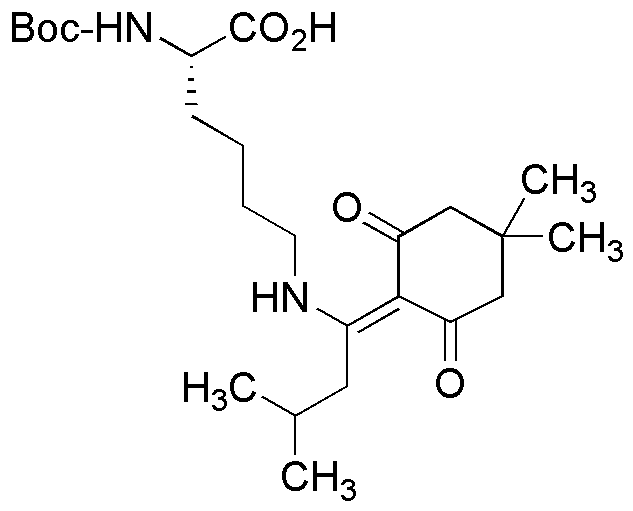Na-Boc-Ne-1-(4,4-dimethyl-2,6-dioxocyclo-hex-1-ylidene)-3-methylbutyl-L-lysine is widely utilized in research focused on:
- Peptide Synthesis: This compound serves as a key building block in the synthesis of peptides, which are essential in drug development and biochemistry. Its unique structure allows for the creation of peptides with specific functionalities.
- Drug Development: The compound is valuable in pharmaceutical research for designing new drugs, particularly those targeting specific biological pathways. Its ability to modify biological activity makes it a candidate for innovative therapeutic agents.
- Bioconjugation: It is used in bioconjugation processes, where it can link biomolecules to drugs or imaging agents, enhancing the efficacy and targeting of therapeutic compounds in cancer treatment.
- Material Science: The compound finds applications in the development of novel materials, particularly in creating polymers with specific properties for use in coatings or biomedical devices.
- Research in Enzyme Inhibition: It is also explored in studies aimed at inhibiting specific enzymes, providing insights into metabolic pathways and potential treatments for various diseases.
General Information
Properties
Safety and Regulations
Applications
Na-Boc-Ne-1-(4,4-dimethyl-2,6-dioxocyclo-hex-1-ylidene)-3-methylbutyl-L-lysine is widely utilized in research focused on:
- Peptide Synthesis: This compound serves as a key building block in the synthesis of peptides, which are essential in drug development and biochemistry. Its unique structure allows for the creation of peptides with specific functionalities.
- Drug Development: The compound is valuable in pharmaceutical research for designing new drugs, particularly those targeting specific biological pathways. Its ability to modify biological activity makes it a candidate for innovative therapeutic agents.
- Bioconjugation: It is used in bioconjugation processes, where it can link biomolecules to drugs or imaging agents, enhancing the efficacy and targeting of therapeutic compounds in cancer treatment.
- Material Science: The compound finds applications in the development of novel materials, particularly in creating polymers with specific properties for use in coatings or biomedical devices.
- Research in Enzyme Inhibition: It is also explored in studies aimed at inhibiting specific enzymes, providing insights into metabolic pathways and potential treatments for various diseases.
Documents
Safety Data Sheets (SDS)
The SDS provides comprehensive safety information on handling, storage, and disposal of the product.
Product Specification (PS)
The PS provides a comprehensive breakdown of the product’s properties, including chemical composition, physical state, purity, and storage requirements. It also details acceptable quality ranges and the product's intended applications.
Certificates of Analysis (COA)
Search for Certificates of Analysis (COA) by entering the products Lot Number. Lot and Batch Numbers can be found on a product’s label following the words ‘Lot’ or ‘Batch’.
Número de catálogo
Número de lote/lote
Certificates Of Origin (COO)
This COO confirms the country where the product was manufactured, and also details the materials and components used in it and whether it is derived from natural, synthetic, or other specific sources. This certificate may be required for customs, trade, and regulatory compliance.
Número de catálogo
Número de lote/lote
Safety Data Sheets (SDS)
The SDS provides comprehensive safety information on handling, storage, and disposal of the product.
DownloadProduct Specification (PS)
The PS provides a comprehensive breakdown of the product’s properties, including chemical composition, physical state, purity, and storage requirements. It also details acceptable quality ranges and the product's intended applications.
DownloadCertificates of Analysis (COA)
Search for Certificates of Analysis (COA) by entering the products Lot Number. Lot and Batch Numbers can be found on a product’s label following the words ‘Lot’ or ‘Batch’.
Número de catálogo
Número de lote/lote
Certificates Of Origin (COO)
This COO confirms the country where the product was manufactured, and also details the materials and components used in it and whether it is derived from natural, synthetic, or other specific sources. This certificate may be required for customs, trade, and regulatory compliance.


